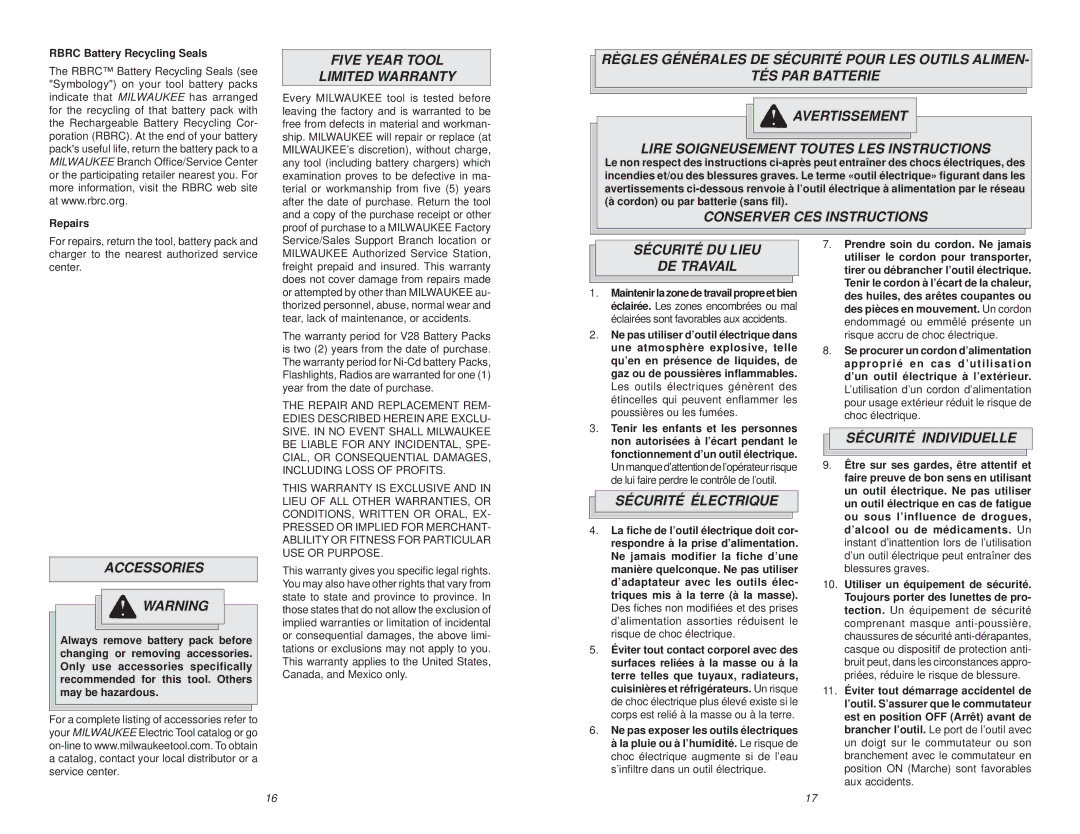
RBRC Battery Recycling Seals
The RBRC™ Battery Recycling Seals (see "Symbology") on your tool battery packs indicate that MILWAUKEE has arranged for the recycling of that battery pack with the Rechargeable Battery Recycling Cor- poration (RBRC). At the end of your battery pack's useful life, return the battery pack to a MILWAUKEE Branch Office/Service Center or the participating retailer nearest you. For more information, visit the RBRC web site at www.rbrc.org.
Repairs
FIVE YEAR TOOL
LIMITED WARRANTY
Every MILWAUKEE tool is tested before leaving the factory and is warranted to be free from defects in material and workman- ship. MILWAUKEE will repair or replace (at MILWAUKEE’s discretion), without charge, any tool (including battery chargers) which examination proves to be defective in ma- terial or workmanship from five (5) years after the date of purchase. Return the tool and a copy of the purchase receipt or other proof of purchase to a MILWAUKEE Factory
RÈGLES GÉNÉRALES DE SÉCURITÉ POUR LES OUTILS ALIMEN-
TÉS PAR BATTERIE
![]()
![]()
![]() AVERTISSEMENT
AVERTISSEMENT
LIRE SOIGNEUSEMENT TOUTES LES INSTRUCTIONS
Le non respect des instructions
CONSERVER CES INSTRUCTIONS
For repairs, return the tool, battery pack and charger to the nearest authorized service center.
ACCESSORIES
![]()
![]()
![]() WARNING
WARNING
Always remove battery pack before changing or removing accessories. Only use accessories specifically recommended for this tool. Others may be hazardous.
For a complete listing of accessories refer to your MILWAUKEE Electric Tool catalog or go
Service/Sales Support Branch location or MILWAUKEE Authorized Service Station, freight prepaid and insured. This warranty does not cover damage from repairs made or attempted by other than MILWAUKEE au- thorized personnel, abuse, normal wear and tear, lack of maintenance, or accidents.
The warranty period for V28 Battery Packs is two (2) years from the date of purchase. The warranty period for
THE REPAIR AND REPLACEMENT REM- EDIES DESCRIBED HEREIN ARE EXCLU- SIVE. IN NO EVENT SHALL MILWAUKEE BE LIABLE FOR ANY INCIDENTAL, SPE- CIAL, OR CONSEQUENTIAL DAMAGES, INCLUDING LOSS OF PROFITS.
THIS WARRANTY IS EXCLUSIVE AND IN LIEU OF ALL OTHER WARRANTIES, OR CONDITIONS, WRITTEN OR ORAL, EX- PRESSED OR IMPLIED FOR MERCHANT- ABLILITY OR FITNESS FOR PARTICULAR USE OR PURPOSE.
This warranty gives you specific legal rights. You may also have other rights that vary from state to state and province to province. In those states that do not allow the exclusion of implied warranties or limitation of incidental or consequential damages, the above limi- tations or exclusions may not apply to you. This warranty applies to the United States, Canada, and Mexico only.
SÉCURITÉ DU LIEU
DE TRAVAIL
1.Maintenirlazonedetravailpropreetbien éclairée. Les zones encombrées ou mal éclairées sont favorables aux accidents.
2.Ne pas utiliser d’outil électrique dans une atmosphère explosive, telle qu’en en présence de liquides, de gaz ou de poussières inflammables. Les outils électriques génèrent des étincelles qui peuvent enflammer les poussières ou les fumées.
3.Tenir les enfants et les personnes non autorisées à l’écart pendant le fonctionnement d’un outil électrique. Un manque d’attention de l’opérateur risque de lui faire perdre le contrôle de l’outil.
SÉCURITÉ ÉLECTRIQUE
4.La fiche de l’outil électrique doit cor- respondre à la prise d’alimentation. Ne jamais modifier la fiche d’une manière quelconque. Ne pas utiliser d’adaptateur avec les outils élec- triques mis à la terre (à la masse). Des fiches non modifiées et des prises d’alimentation assorties réduisent le risque de choc électrique.
5.Éviter tout contact corporel avec des surfaces reliées à la masse ou à la terre telles que tuyaux, radiateurs, cuisinières et réfrigérateurs. Un risque de choc électrique plus élevé existe si le corps est relié à la masse ou à la terre.
6.Ne pas exposer les outils électriques à la pluie ou à l’humidité. Le risque de choc électrique augmente si de l’eau s’infiltre dans un outil électrique.
7.Prendre soin du cordon. Ne jamais utiliser le cordon pour transporter, tirer ou débrancher l’outil électrique. Tenir le cordon à l’écart de la chaleur, des huiles, des arêtes coupantes ou des pièces en mouvement. Un cordon endommagé ou emmêlé présente un risque accru de choc électrique.
8.Se procurer un cordon d’alimentation approprié en cas d’utilisation d’un outil électrique à l’extérieur. L’utilisation d’un cordon d’alimentation pour usage extérieur réduit le risque de choc électrique.
SÉCURITÉ INDIVIDUELLE
9.Être sur ses gardes, être attentif et faire preuve de bon sens en utilisant un outil électrique. Ne pas utiliser un outil électrique en cas de fatigue ou sous l’influence de drogues, d’alcool ou de médicaments. Un instant d’inattention lors de l’utilisation d’un outil électrique peut entraîner des blessures graves.
10.Utiliser un équipement de sécurité. Toujours porter des lunettes de pro- tection. Un équipement de sécurité comprenant masque
11.Éviter tout démarrage accidentel de l’outil. S’assurer que le commutateur est en position OFF (Arrêt) avant de brancher l’outil. Le port de l’outil avec un doigt sur le commutateur ou son branchement avec le commutateur en position ON (Marche) sont favorables aux accidents.
16 | 17 |
